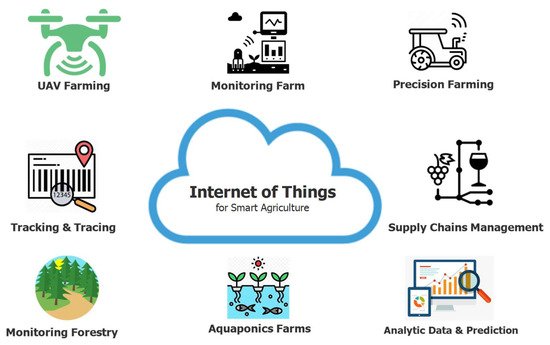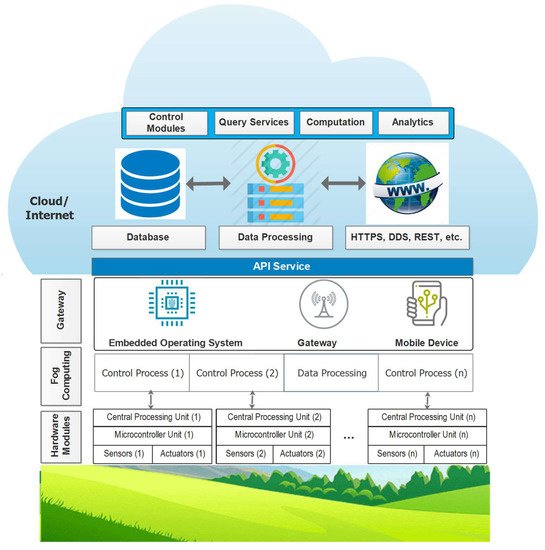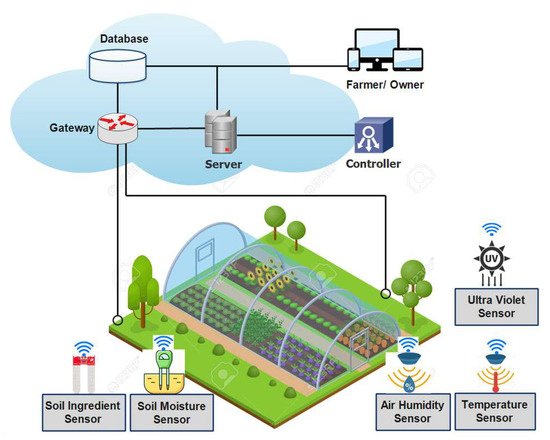The growth of the global population coupled with a decline in natural resources, farmland, and the increase in unpredictable environmental conditions leads to food security is becoming a major concern for all nations worldwide. These problems are motivators that are driving the agricultural industry to transition to smart agriculture with the application of the Internet of Things (IoT) and big data solutions to improve operational efficiency and productivity. The IoT integrates a series of existing state-of-the-art solutions and technologies, such as wireless sensor networks, cognitive radio ad hoc networks, cloud computing, big data, and end-user applications. IoT is defined as the network of all objects that are embedded within devices, sensors, machines, software and people through the Internet environment to communicate, exchange information and interact in order to provide a comprehensive solution between the real world and the virtual world.
1. Introduction
In order to meet the current global needs of humanity, new solutions and technologies are constantly being proposed and implemented. This has led to the advent of the Internet of Things (IoT)
[1][2][1,2]. IoT is defined as the network of all objects that are embedded within devices, sensors, machines, software and people through the Internet environment to communicate, exchange information and interact in order to provide a comprehensive solution between the real world and the virtual world
[3]. In recent years, IoT has been applied in a series of domains, such as smart homes
[4][5][4,5], smart cities
[6][7][6,7], smart energy
[8][9][8,9], autonomous vehicles
[10][11][10,11], smart agriculture
[12][13][14][15][12,13,14,15], campus management
[16][17][16,17], healthcare
[18][19][18,19], and logistics
[20][21][20,21]. Series of other IoT applications have been described by Shafique et al.
[22]. An illustration of rich and diverse IoT applications for smart agriculture is provided in
Figure 1.
Figure 1.
An illustration of IoT applications for smart agriculture.
According to the United Nations’ (UN 2019) statistics, the world population is estimated to grow to 10 billion by 2050
[23]. As a consequence, the requirements of agricultural products are continually increasing. However, farmlands are declining, natural resources are increasingly depleted, and the rise of unpredictable nature challenges, such as global warming, salinization, and flooding, make food security the most concerning problem for all nations worldwide.
In recent years, with the aim of increasing agricultural production, new solutions and technologies have been introduced in the agriculture sector
[24]. An emerging trend is the application of the IoT and big data. A significant number of studies have been focused on research, experiments, and applications
[25][26][25,26]. According to the Cisco forecast, over 500 billion IoT devices will be connected to the Internet by 2030
[27]. The use of IoT and big data will enable smart agriculture and is expected to enhance efficiency and productivity
[28].
Over the years, wireless sensor networks (WSN) have been strongly applied in the agricultural sector, building the foundation for developing smart agriculture
[29]. The unique characteristics of WSN, such as the ability to self-organize, self-configure, self-establish, and self-recover, make it suitable for smart agriculture
[30]. The sensor device consists of a radio frequency (RF) transceiver, sensor, microcontroller, and battery power
[31]. The WSN focuses on applications such as environmental monitoring, machine control automation, and traceability
[32][33][34][35][32,33,34,35].
Along with the development of science and technology, the urgent requirement for breakthrough solutions and technologies aiming at improving productivity and efficiency in the agriculture sector has led to adoption of the IoT. The primary motivation for their applications is the breakthrough progress of smart agriculture and its inevitable role as the future of smart and sustainable environment management. IoT integrates a series of existing solutions and technologies, such as WSN, cognitive radio, ad hoc networks, cloud computing, and end-user applications
[36]. In the smart agricultural sector, automation solutions and technologies, mechanical machines, knowledge, decision-making tools, services, and software are integrated seamlessly to help farmers improve productivity, product quality, and profitability
[37].
2. Typical Applications of IoT in Smart Agriculture
2.1. Monitoring
In the agriculture sector, factors affecting the farming and production process can be monitored and collected, such as soil moisture, air humidity, temperature, pH level, etc. These factors depend on the considered agricultural sector. Some smart agricultural sectors are applying the following monitoring solutions:
Crop Farming: In this sector, some vital factors that affect the farming process and production efficiency include air temperature, precipitation, air humidity, soil moisture, salinity, solar radiation, pest status, soil nutrient ingredients, etc. In
[38][81], the
resea
rcheuthors designed an IoT device called FarmFox. This device allows real-time collection and analysis of the composition of the farming soil and transmits the information to farmers/owners via the Internet. The results demonstrate the health of the soil is monitored in real time to provide timely recommendations to farmers aiming to increase productivity and farming efficiency.
Furthermore, in
[39][82], the
resea
rcheuthors proposed an IoT device to allow intelligent control of temperature and humidity factors, called a weather radar. This device will automatically turn on the warning mode using the light signal and send messages to the farmer when the temperature or humidity exceeds a pre-installed threshold. In
[40][83], the
resea
rcheuthors introduced an IoT system based on Web GIS to monitor pest status and provide early warnings. In addition, this study also proposes a predictive model based on monitoring the habitat of pests and diseases. The efficiency of the proposed system was indicated, based on the predicted figures of the locust epidemic, to have a high accuracy rate (over 87%) in 2019 (China).
Monitoring information, such as soil condition, moisture, and temperature, and the prediction of natural factors, such as rainfall and weather, support the control of growing conditions of crops, helping farmers plan and make irrigation decisions to optimize production and reduce labour costs. In addition, the collected data, combined with big data processing technology, can provide recommendations for implementing preventive and remedial solutions against pests and diseases in farming.
Aquaponics: It is an integration of aquaculture and hydroponics. Aquaponics is a farming technique where fish waste becomes a source of nutrients needed by plants. One of the most important issues in such farms is constantly monitoring water quality, water level, temperature, salinity, pH, sunlight, etc.
[41][84]. According to this research direction, in
[42][85], the
rese a
rcheuthors designed an IoT system to monitor the temperature and pH value of water for aquaponics farms. Moreover, this system is also equipped with a control system of water metrics to keep the fish habitat stable and an automatic fish feeding function to increase the productivity of the fish. The results show that the IoT system had stable operation and provided real-time monitoring parameters. The
researche authors of
[43][86] designed an aquaponics farm for households/urban areas based on IoT. This system recommends the proper ratio of fish and plants.
Consequently, the system decreases feed consumption as well as reduces carbon emissions into the environment. The primary purpose of this proposal aims to balance the self-sustaining ability of the aquaponics system. The experimental results demonstrate the number of fish decreases from 30 to 15, and the number of plants increases from 20 to 30, but the crop production will increase by more than 50%. A detailed and diverse survey of the IoT systems and devices for control and monitoring of aquaponics farms is introduced in
[44][87]. Based on the obtained data, monitoring can improve the production of fish and plants through the control, supplementation, and regulation of nutritional ingredients in the water. The collected data were also used to automate the management of aquaponics farms to reduce labour costs.
Forestry: Humans depend on forests for survival. Moreover, forests play a vital role in the carbon cycle and provide a habitat for more than two-thirds of animal species in the world. Forests also have the effect of protecting watersheds, limiting floods, and mitigating climate change. The main factors that need to be monitored in a forest include soil ingredients, air temperature, humidity, and concentration of several different gases, such as oxygen, methane, ammonia, and hydrogen sulphide. A series of forest control systems and solutions are presented in
[45][46][88,89] based on IoT and big data analytics.
Livestock Farming: It is defined as the process of raising domesticated animals, such as cows, pigs, sheep, and goats, chickens, etc., in an agricultural environment to obtain traction, serve production, and obtain products such as meat, eggs, milk, fur, leather, etc. In this area, the factors to be monitored depend on the type and number of farming animals
[47][92]. In
[48][93], the
rese a
rcheuthors designed a support system for the diagnosis, prevention, and treatment of diseases for livestock called VetLink. This system can provide recommendations for animal health for farmers in rural areas where it is difficult to access veterinary doctors immediately. In
[49][94], the
resea
rcheuthors proposed a noncontact temperature measurement system and monitoring of animals to ensure early detection of diseases and animal health. This system can be used for remote monitoring of animal health and timely anomaly detection. In
[50][95], the
rese a
rcheuthors introduced a monitoring system for large-scale pig farms based on IoT. The specific solution is to attach an IC tag on each pig to monitor the behaviour of each pig, such as their period of feeding and resting and exercise. Data from sensors are collected and combined with data analytics solutions that can make recommendations for pig health.
The monitoring data of water, feed, and animal health for livestock in the farming process helps farmers set up livestock plans, reduce labour costs, and enhance production efficiency. While a series of solutions has been provided for monitoring large-scale farms, their application in small and medium-sized farms is very limited, especially in developing countries. This can be attributed to the high cost and the lack of knowledge needed to set up, manage, and operate IoT systems. Therefore, effective and low-cost solutions for agricultural IoT have much potential.
2.2. Tracking and Tracing
In order to meet the needs of consumers and increase profit value, in the future, farms need to demonstrate that products offered to the market are clean products and can be tracked and traced conveniently, thereby enhancing the trust of consumers in product safety and health-related issues. In order to solve this problem, a series of tracking- and tracing-based problems for the smart agricultural sector has been proposed, specifically as follows:
In
[51][96], the
resea
rcheuthors designed an information system that allows tracking and tracing of agricultural products and foods such as dairy and vegetables, called SISTABENE. This system helps suppliers track the production process and errors arising in the supply chain, and helps end-users trace the origin of food. In
[52][97], the
rese a
rcheuthors proposed a food supply chain traceability system based on blockchain technology. It helps to track and trace agrifood supply chains’ production process and trace the origin of agricultural products. This solution has been employed at Shanwei Lvfengyuan Modern Agricultural Development Co., Ltd. (Shanwei, China). Although there are still limitations, the results demonstrate that this solution has successfully supported the tracing of food and agricultural products through QR codes, improving product quality and ensuring the clear traceability of products. In
[53][54][98,99], the
rese a
rcheuthors proposed smart agricultural solutions to tracking and tracing agricultural products, thereby allowing consumers to know the product’s entire history. These solutions enable tracking and tracing some of the data collected along the supply chain, ensuring that consumers and other stakeholders can identify products’ origin, location, and history.
2.3. Smart Precision Farming
The advent of the GPS (global positioning system) has created breakthrough advances in many fields of science and technology. The GPS provides the most important parameters for locating a device, such as location and time. GPS systems have been successfully deployed in many fields, such as smartphones, vehicles, and IoT ecosystems. However, GPS is only good support for outdoor systems and the sky. Meanwhile, the demand for the locating and navigating systems in the home and on the streets of smart cities is growing rapidly. Aiming to solve this problem, an advanced global navigation satellite system (GNSS) is being deployed
[55][100]. Based on GPS and GNSS systems, suitable farming maps have been established for fields and farms. As a result, agricultural machinery and equipment can be operated autonomously
[56][101].
Figure 2 6 presents an illustration of the typical cloud-assisted, IoT-based precision agriculture platform.
Figure 26.
Cloud-assisted IoT-based precision agriculture platform.
In smart precision farming, one of the most important applications is the use of drones in monitoring and farming activities. Some common farming tasks using UAVs include spraying pesticides, fertilizing, sowing seeds, evaluating and mapping, and monitoring crop growth. In
[57][102], the
rese a
rcheuthors presented a detailed survey of drone applications for smart agriculture, including applications, control technology, and future trends of the UAV application for smart agriculture. In
[58][103], the
resea
rchersuthors designed an automatic agricultural product classification system based on camera systems, image processing algorithms, and mechanical actuators. The experimental results for agriculture products such as oranges and tomatoes present a classification success rate of over 95%, and the sorting time for each product is less than 1(s). This solution can be adapted and applied to the classification of different agricultural products. In
[59][104], the
rese a
rcheuthors proposed a solution to estimate grape production. The proposed solution combines an RGB-D camera mounted on a mobile robot platform and size estimation algorithm for a bunch of grapes. The experimental results present an average error in the range of [2.8–3.5] (cm). The results demonstrate this solution is a feasible method for evaluating the productivity of large-scale grape farms.
Smart precision farming helps to improve productivity and production efficiency and is suitable for large-scale farms. Nowadays, suppliers of precision agricultural equipment have IoT modules built into their machines, allowing machines to operate autonomously and remotely via the Internet
[60][107].
2.4. Greenhouse Production
A greenhouse consists of walls and a roof, which are usually made from transparent materials, such as plastic or glass. In a greenhouse, plants are grown in a controlled environment, including controlling for moisture, nutrient ingredients of the soil, light, temperature, etc. Consequently, greenhouse technology makes it possible for humans to grow any plant, at any time, by providing suitable environmental conditions
[61][108].
Figure 3 7 illustrates a smart agriculture IoT system for monitoring greenhouse farming factors based on IoT ecosystems.
Figure 37.
An illustration of IoT application for monitoring farming conditions in a greenhouse.
Recent studies indicated that solutions integrating IoT, big data processing, and artificial intelligence could be applied in greenhouses to reduce labour and energy efficiency. Moreover, it also provides direct connections between the greenhouse farms and the customer
[62][63][64][65][112,113,114,115].



